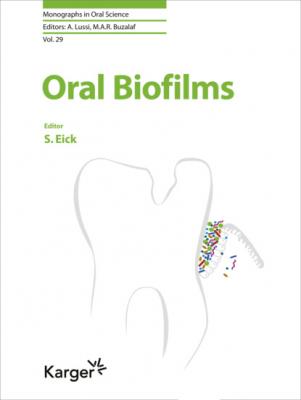Oral Biofilms. Группа авторов
Читать онлайн.| Название | Oral Biofilms |
|---|---|
| Автор произведения | Группа авторов |
| Жанр | Медицина |
| Серия | Monographs in Oral Science |
| Издательство | Медицина |
| Год выпуска | 0 |
| isbn | 9783318068528 |
7Jefferson KK: What drives bacteria to produce a biofilm? FEMS Microbiol Lett 2004;236:163–173.
8Karatan E, Watnick P: Signals, regulatory networks, and materials that build and break bacterial biofilms. Microbiol Mol Biol Rev 2009;73:310–347.
9Stoodley P, Dodds I, Boyle J, Lappin-Scott H: Influence of hydrodynamics and nutrients on biofilm structure. J Appl Microbiol 1998;85(Suppl 1):19S–28S.
10Bowden GH, Hamilton IR: Survival of oral bacteria. Crit Rev Oral Biol Med 1998;9:54–85.
11Hall-Stoodley L, Costerton J, Stoodley P: Bacterial biofilms: from the natural environment to infectious diseases. Nat Rev Microbiol 2004;2:95–108.
12Wilson M: Use of constant depth film fermentor in studies of biofilms of oral bacteria. In: Doyle RJ (ed): Methods in Enzymology 310. San Diego, Academic Press, 1999, pp 264–279.
13Pratten J: Growing oral biofilms in a constant depth film fermentor (CDFF). Curr Protoc Microbiol 2007;6:1B.5.1–18.
14Periasamy S, Kolenbrander P: Central role of the early colonizer Veillonella sp. in establishing multispecies biofilm communities with initial, middle, and late colonizers of enamel. J Bacteriol 2010;192:2965–2972.
15Schlafer S, Raarup MK, Wejse PL, Nyvad B, Stadler BM, Sutherland DS, et al: Osteopontin reduces biofilm formation in a multi-species model of dental biofilm. PLoS One 2012;7:e41534.
16Oettinger-Barak O, Dashper S, Catmull D, Adams G, Sela M, Machtei E, et al: Antibiotic susceptibility of Aggregatibacter actinomycetemcomitans JP2 in a biofilm. J Oral Microbiol 2013;5:20320.
17Coenye T, Nelis H: In vitro and in vivo model systems to study microbial biofilm formation. J Microbiol Methods 2010;83:89–105.
18Ammann T: Advancement and structural analysis of a subgingival biofilm model system. PhD thesis, University of Zurich, 2013.
19Guggenheim B, Giertsen E, Schüpbach P, Shapiro S: Validation of an in vitro biofilm model of supragingival plaque. J Dent Res 2001;80:363–370.
20Guggenheim B, Guggenheim M, Gmür R, Giertsen E, Thurnheer T: Application of the Zürich biofilm model to problems of cariology. Caries Res 2004;38:212–222.
21Guggenheim M, Shapiro S, Gmür R, Guggenheim B: Spatial arrangements and associative behavior of species in an in vitro oral biofilm model. Appl Environ Microbiol 2001;67:1343–1350.
22Shapiro S, Giertsen E, Guggenheim B: An in vitro oral biofilm model for comparing the efficacy of antimicrobial mouthrinses. Caries Res 2002;36:93–100.
23Ammann TW, Belibasakis GN, Thurnheer T: Impact of early colonizers on in vitro subgingival biofilm formation. PLoS One 2013;8:e83090.
24Ammann T, Bostanci N, Belibasakis G, Thurnheer T: Validation of a quantitative real-time PCR assay and comparison with fluorescence microscopy and selective agar plate counting for species-specific quantification of an in vitro subgingival biofilm model. J Periodontal Res 2013;48:517–526.
25Ammann T, Gmur R, Thurnheer T: Advancement of the 10-species subgingival Zurich Biofilm model by examining different nutritional conditions and defining the structure of the in vitro biofilms. BMC Microbiol 2012;12:227.
26Guggenheim B, Gmur R, Galicia J, Stathopoulou P, Benakanakere M, Meier A, et al: In vitro modeling of host-parasite interactions: the “subgingival” biofilm challenge of primary human epithelial cells. BMC Microbiol 2009;9:280.
27Thurnheer T, Bostanci N, Belibasakis G: Microbial dynamics during conversion from supragingival to subgingival biofilms in an in vitro model. Mol Oral Microbiol 2016;31:125–135.
28Thurnheer T, Belibasakis G, Bostanci N: Colonisation of gingival epithelia by subgingival biofilms in vitro: role of “red complex” bacteria. Arch Oral Biol 2014;59:977–986.
29Thurnheer T, Rohrer E, Belibasakis G, Attin T, Schmidlin P: Static biofilm removal around ultrasonic tips in vitro. Clin Oral Investig 2014;18:1779–1784.
30Kolenbrander PE, Andersen RN, Blehert DS, Egland PG, Foster JS, Palmer RJ Jr: Communication among oral bacteria. Microbiol Mol Biol Rev 2002;66:486–505.
31Thurnheer T, Belibasakis G: Effect of sodium fluoride on oral biofilm microbiota and enamel demineralization. Arch Oral Biol 2018;89:77–83.
32Thurnheer T, Gmür R, Guggenheim B: Multiplex FISH analysis of a six-species bacterial biofilm. J Microbiol Meth 2004;56:37–47.
33Thurnheer T, Gmür R, Shapiro S, Guggenheim B: Mass transport of macromolecules within an in vitro model of supragingival plaque. Appl Environ Microbiol 2003;69:1702–1709.
34Thurnheer T, van der Ploeg J, Giertsen E, Guggenheim B: Effects of Streptococcus mutans gtfC deficiency on mixed oral biofilms in vitro. Caries Res 2006;40:163–171.
35Gartenmann S, Thurnheer T, Attin T, Schmidlin P: Influence of ultrasonic tip distance and orientation on biofilm removal. Clin Oral Investig 2016;21:1029–1036.
36Socransky S, Haffajee A, Cugini M, Smith C, Kent RJ: Microbial complexes in subgingival plaque. J Clin Periodontol 1998;25:134–144.
37Kolenbrander PE, London J: Adhere today, here tomorrow: oral bacterial adherence. J Bacteriol 1993;175:3247–3252.
38Belibasakis GN, Kast JI, Thurnheer T, Akdis CA, Bostanci N: The expression of gingival epithelial junctions in response to subgingival biofilms. Virulence 2015;6:704–709.
39Bostanci N, Bao K, Wahlander A, Grossmann J, Thurnheer
